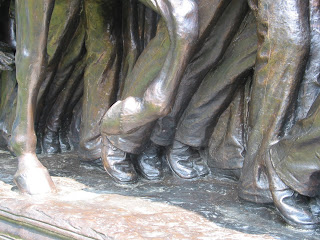At dawn, before anyone else is stirring in the house, after the coffee is brewing, Bella and I wander down the field roads and woodland trail to the "back forty." In these last days of August the gray birches are turning yellow, the wild and invasive shrubs and vines are laden with fruit, and the summer crops are giving way to the hardy fall crops.
Families of songbirds forage in the fields, and shrubs, and wetland edges, preparing for fall flight. Four young of the year barn swallows sit side-by-side on a thin branch a few feet above the water, as mother swallow swoops in with an insect for one of her young, their mouths wide open. A gorgeous coyote, with a thick gray-brown coat and long bushy black-tipped tail, hunts for mice and voles among tall goldenrod, queen-anne's-lace, and grasses.
The farmers, interns, and volunteers have toiled all summer to grow food for Brookfield Farm, a CSA that leases some of our land. The fruits of their labor are visible in every field.
 Entire fields replanted with fall crops of Brussels sprouts,
Entire fields replanted with fall crops of Brussels sprouts,red and green cabbages.
 In the thickets around the fields,
In the thickets around the fields,wild common elderberries (Sambucus canadensis)
droop with dark purple berries.
 Wild apples are red and crisp and sour.
Wild apples are red and crisp and sour. The invasive shrubs are also laden with fruit.
The invasive shrubs are also laden with fruit.Autumn olive (Elaegnus umbellata)
with stems dripping in bright fruit
call out for fruit-eating birds and mammals.
 My sister Amy has grown amazing garlic for several years on Winterberry Farm. Planted last October, pulled from the ground in July to dry for a month or more, this weekend we trimmed and sorted. More than 350 bulbs! One hundred (with 5-6 large cloves in each bulb) of the biggest were saved for planting the next crop. I have a bag of 100 bulbs to take home for cooking in the coming year. This is farm gold!
My sister Amy has grown amazing garlic for several years on Winterberry Farm. Planted last October, pulled from the ground in July to dry for a month or more, this weekend we trimmed and sorted. More than 350 bulbs! One hundred (with 5-6 large cloves in each bulb) of the biggest were saved for planting the next crop. I have a bag of 100 bulbs to take home for cooking in the coming year. This is farm gold!








































